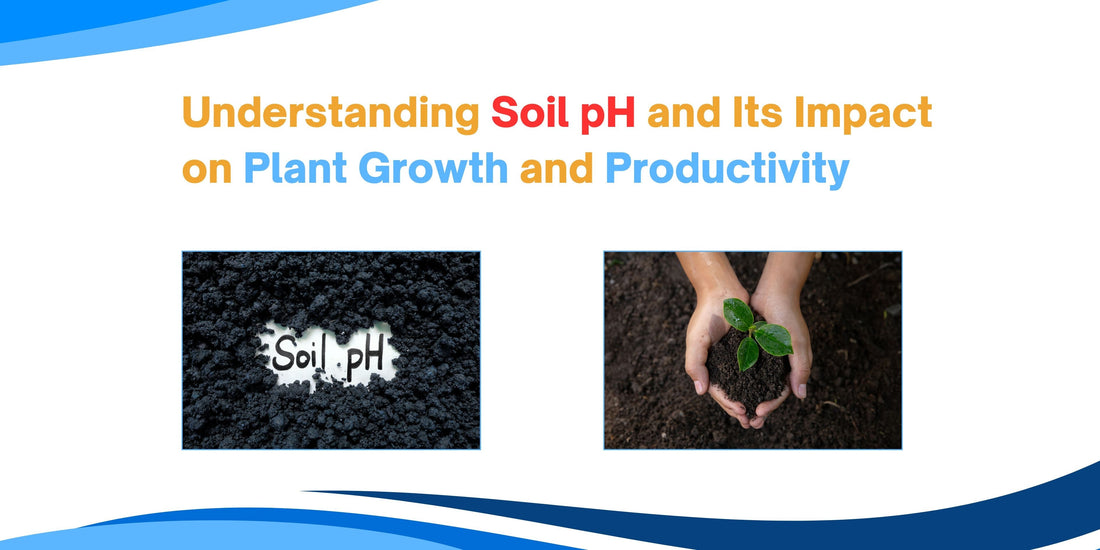
Understanding Soil pH and Its Impact on Plant Growth and Productivity
Introduction
Healthy soil is the foundation of a productive farm. Just like humans need a balanced diet to stay healthy, plants need balanced soil conditions to grow well. One of the most important — yet often overlooked — factors in soil health management is soil pH.
Soil pH determines whether essential nutrients in the soil are available for plant roots to absorb. Imbalanced pH can affect fertilizer efficiency, crop yield, and overall farm profitability. Therefore, understanding and managing soil pH is key to achieving better plant growth and sustainable productivity.
What is Soil pH?
Soil pH is a measure of how acidic or alkaline the soil is. It is measured on a scale from 0 to 14:
- pH 7 is neutral
- Below 7 means the soil is acidic
- Above 7 means the soil is alkaline
The soil pH level influences chemical, biological, and physical properties of the soil. It directly affects how well nutrients like nitrogen, phosphorus, potassium, and micronutrients (zinc, iron, manganese) are available to plants.
In simple terms — if the pH balance of soil is wrong, plants cannot take up nutrients properly, even if fertilizers are applied in sufficient quantities.
Ideal Soil pH Range for Major Crops
Different crops prefer different pH ranges for optimal growth. Here’s a general guide for farmers:
| Crop Type | Ideal pH Range |
|---|---|
| Rice | 5.5 – 6.5 |
| Wheat | 6.0 – 7.5 |
| Maize (Corn) | 6.0 – 7.0 |
| Cotton | 6.0 – 8.0 |
| Pulses (like Red gram, Green gram) | 6.0 – 7.5 |
| Vegetables | 6.0 – 7.0 |
| Sugarcane | 6.5 – 7.5 |
| Fruit crops (Banana, Mango, Citrus) | 5.5 – 7.0 |
Maintaining this pH balance for crops ensures maximum nutrient availability, better microbial activity, and improved root growth — leading to higher yields and better quality produce.
Effects of Low and High Soil pH
1. Low Soil pH (Soil Acidity)
When soil pH falls below 6.0, it becomes acidic, leading to several issues:
- Reduced availability of nutrients like phosphorus, calcium, and magnesium
- Increased solubility of toxic metals like aluminum and manganese, which harm roots
- Poor microbial activity and reduced nitrogen fixation in legumes
- Stunted plant growth and lower yields
Common in: high rainfall areas, excessive nitrogen fertilizer use, or continuous monocropping without liming.
2. High Soil pH (Soil Alkalinity)
When soil pH is above 7.5, the soil becomes alkaline, which can cause:
- Nutrient deficiencies, especially of iron, zinc, and manganese
- Hard, compact soil with poor structure
- Slow decomposition of organic matter
- Chlorosis (yellowing of leaves) and poor root development
Common in: arid and semi-arid regions, areas with saline irrigation water, or overuse of basic fertilizers.
How to Test Soil pH
Testing soil pH is the first step toward effective soil health management. Farmers can determine their soil pH in several ways:
-
Soil Testing Labs:
Collect soil samples from your field (4–6 inches deep) and send them to an authorized laboratory. The lab report will give you pH and nutrient status. -
Digital Soil pH Meters:
Portable pH meters provide instant readings and are useful for frequent testing. -
pH Indicator Kits or Strips:
A simple and affordable method for small farmers — mix soil with water and dip the strip to know pH level based on color.
Tip: Always test soil before the sowing season and after major crop cycles to track pH changes over time.
Ways to Correct Soil pH (with Product-Based Examples)
After identifying whether your soil is acidic or alkaline, corrective actions can bring back the right balance.
For Acidic Soils (Low pH):
Apply Lime (Calcium Carbonate):
Lime neutralizes acidity and improves soil structure.
- Use products like Agri Lime or Dolomite Lime based on soil test results.
- Apply during land preparation and mix well with topsoil.
Use Organic Matter:
Farmyard manure and compost enhance buffering capacity and microbial activity.
Bio-Based Soil Conditioners:
Products like Soil Plus or BioCare pH Balancer help naturally correct soil acidity through microbial action and organic compounds.
For Alkaline Soils (High pH):
Apply Gypsum (Calcium Sulfate):
Gypsum replaces sodium ions and improves soil permeability.
- Ideal for sodic or saline-alkaline soils.
- Use Agricultural Grade Gypsum at recommended doses per acre.
Add Organic Amendments:
Green manures, compost, and biofertilizers enhance microbial diversity and slowly reduce pH.
Use Bioacidifiers and Microbial Products:
Products containing Trichoderma, Pseudomonas, or Plant Growth Promoting Rhizobacteria (PGPR) help restore soil balance and promote root health.
Balanced Fertilization:
Avoid excessive use of urea or basic fertilizers in alkaline soils. Instead, use acidic fertilizers like ammonium sulfate or single super phosphate (SSP).
Conclusion: Build Strong Roots with Balanced Soil pH
Soil pH plays a silent but powerful role in determining crop success. Balanced pH not only boosts nutrient uptake but also improves microbial life, soil structure, and overall productivity. Regular testing and timely correction are essential steps toward sustainable soil health management.
As a farmer, taking care of your soil means taking care of your future harvest. If you notice poor crop growth or nutrient deficiency despite applying fertilizers, your soil pH might be the hidden reason.
👉 Check your soil pH today — balance your soil, boost your yields, and grow profitably with our agri-input solutions!
